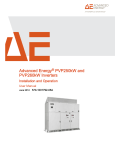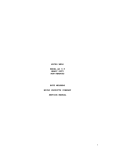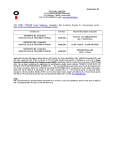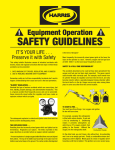Download model ad 6-10 heavy duty non-ferrous butt welders
Transcript
MICRO WELD MODEL AD 6-10 HEAVY DUTY NON-FERROUS BUTT WELDERS MICRO PRODUCTS COMPANY SERVICE MANUAL 1 TABLE OF CONTENTS 1.0 2.0 3.0 4.0 5.0 6.0 7.0 8.0 9.0 10.0 11.0 12.0 13.0 SPECIFICATIONS GENERAL OPERATING INSTRUCTIONS BASIC OPERATING PARTS BASIC OPERATING PARTS LOCATION TYPICAL OPERATING SEQUENCE SPECIAL ADJUSTMENTS PREVENTIVE MAINTENACE SUGGESTED SETTINGS DIAGNOISTIC CHART FOR TROULBE-SHOOTING ELECTRICAL SCHEMATIC SAFETY REMINDERS BUYERS GUIDE PARTS LIST SPECIFICATIONS Welding Range Copper Wire Welding Range Aluminum Wire Welding Range Copper Conductors Welding Range Aluminum Conductors Maximum Line Demand 460 Volt Maximum Line Demand 575 Volt Single Phase AC Transformer Clamp Method Upset Method Mounting MODEL AD-6 .550 to 1.000 in. dia. .625 to 1.375 in. dia. in. dia. 250MCM to 1000MCM in. dia. 400MCM to 1250MCM 584 amps@100% duty cycle 1306 amps@20% duty cycle 467amps@100% duty cycle 1044amps@20% duty cycle 380 KVA @ 50% duty cycle Pneumatic, Foot Controlled Pneumatic, Adjustable 4-Caster Wheels Dimensions and Weights Height Overall Floor Space Welding Die Height Weight SPECIFICATIONS Welding Range Copper Wire Welding Range Aluminum Wire Welding Range Copper Conductors Welding Range Aluminum Conductors Maximum Line Demand 460 Volt Maximum Line Demand 575 Volt Single Phase AC Transformer Clamp Method Upset Method Mounting 50 in. 85 in. x 40 in. 44 in. 4800LBS MODEL AD-8 .550 to 1.125 in. dia. .750 to 1.750 in. dia. in. dia. 250MCM to 1250MCM in. dia. 500MCM to 2000MCM 784amps@100% duty cycle 1569amps@25% duty cycle 627amps@100% duty cycle 1255amps@25% duty cycle 510 KVA @ 50% duty cycle Pneumatic, Foot Controlled Pneumatic, Adjustable 4-Caster Wheels MODEL AD-10 .500 to 1.300 in. dia. .500 to 1.750 in. dia. .500 to 1.600 in. dia. .500 to 1.750 in. dia. 784amps@100% duty cycle 2000amps@15% duty cycle 627amps@100% duty cycle 1600amps@15% duty cycle 510 KVA @ 50% duty cycle Pneumatic, Foot Controlled Pneumatic, Adjustable 4-Caster Wheels Dimensions and Weights Height Overall Floor Space Welding Die Height Weight 50 in. 85 in. x 40 in. 44 in. 5400 LBS 50 in. 85 in. x 40 in. 44 in. 5400 LBS 2 FEATURES • • • • • • • • Micro Weld quality and workmanship Heavy-duty construction & components Easy to operate controls Low maintenance costs Easy to set welding parameters Safety electrical switch circuits Heavy-duty weld heat selection switch Sensitive straight slide movable headpiece assembly 2.0 GENERAL OPERATING INSTRUCIONS 2.1 ELECTRICAL HOOK-UP INSTRUCTIONS First determine that available electrical service in your plant corresponds to the nameplate rating located on welder housing. Electrical wiring to welder must be of sufficient size to deliver full ampere load with no appreciable loss during weld cycle. The welder will not operate properly if there is more than a 10% variation in the line voltage. In general, the welder should be fused with a slow blow fuse of the 100% duty cycle rating. The minimum power cable size to the welder can be obtained by using this same current rating. Refer to National Electrical Code and local electrical regulations for adequate power sizes; disconnect methods and fusing guidelines. Remember, line voltages to the welding machine are potentially dangerous should the power cords be damaged or severed. The welding voltages at the welding dies will not harm an operator since they do not exceed 10 volts. 2.2 SAFETY PRECAUTIONS (See section 11.0) 2.2.1 ELECTRICAL Maintain electrical cable to welder in good repair. Welder must be grounded and connections securely tightened. Heat Switch must not be changed to new position while a weld cycle is in process. Disconnect electrical service before serving welder – high voltages are located within the base of the welder. 3 2.2.2 MECHANICAL Operator while using welder must wear safety glasses. Keep all safety guards on welders and use properly. Operators must be instructed on basic operation of unit to prevent injury. Check nameplate rating and keep within material size range for each welder. 2.3 WATER HOOK-UP (If so equipped) It is important that if a welder is to be operated for an extended period of time and head heat up, water lines must be connected to the welder. Connect hoses to inlet and outlet provided at the back of the welder. Shut-off valve should be installed in the inlet line and the hose from the outlet should run to an open sight drain. Water should be turned off when welder is not in use. 2.4 AIR HOOK-UP Set air regulators for from 20 to 90 lbs. A safety pop-off valve will be activated when air gauge is set for over 100 lbs. 2.5 WELDING DIES The dies and shoes supplied with the welder will handle most size and material types within the range of the welder. For new weld applications consult the factory for special die and shoe sets. 4 3.0 BASIC OPERATING PARTS 3.1 MODEL AD-6 or 8 3.1.1 WELD HEAT SELECTION SWITCH The AD-6 welding heat is selected by means of a heavy-duty Tap switch with 8 steps of voltage. Number 1 indicates the highest heat setting and the number 8 indicates the lowest heat setting. Other numbers are equally graduated from highest to low to allow just the right amount of voltage for the weld operation. The type of heat switch found on the switch that must be depressed before This safety switch actually is wired circuit, and when the heat switch is prohibit the welder welding. AD-6 has a safety turning to a new heat. into the control between settings will 3.2.1 The AD-8 welding heat is selected by means of an SCR control mounted on the side of the welder. A potentiometer located on the control front panel with a scale designating 0-100%. 0% is the lowest heat setting. 100% is the highest heat setting. 3.2.2 CLOSED HEAD SPACE ADJUSTMENT The closed headspace adjustment bolt is located on the movable headpiece end plate. Refer to Item A. 3.2.3 OVERTRAVEL INERTIA LIMITING SCREW The over-travel inertia limiting screw is located on the movable headpiece end plate. Refer to Item B. 3.2.4 OPEN HEAD SPACE ADJUSTMENT The open headspace adjustment bolt is located on the upset mechanism opposite the over travel inertia limiting screw. Refer to Item C. 3.2.5 HIGH PRESSURE TRACEL STOP SCREW The high-pressure travel stop screw is located on the upset mechanism, threaded into the upset lever arm and beneath the upset lever limiting bridge. Refer to Item D. 5 3.2.6 LOW PRESSURE TRAVEL LIMITING SCREW The low-pressure travel limiting screw is located on the upset mechanism, threaded into the upset lever arm and beneath the upset lever limiting bridge. Refer to Item E. 3.2.7 LIMIT SWITCH ADJUSTING SCREW The limit switch adjusting screw is located on the upset lever arm. Refer to Item F. 3.2.9 TOGGLE LINK The toggle link is located in the middle of the upset mechanism. Refer to Item G. 3.2.10 UPSET LEVER LIMITING BRIDGE The upset lever limiting bridge is located in the middle of the upset mechanism. Refer to Item H. 3.2.11 UPSET LEVER ARM The upset lever arm is located in the middle of the upset mechanism. Refer to Item I. 6 4.0 BASIC OPERATING PARTS LOCATION 7 5.0 5.1 5.2 5.3 5.4 5.5 5.6 5.7 TYPICAL OPERATING SEQUENCE All insulating materials must be removed from conductors where they contact lower welding dies. Set weld heat selection switch to recommended chart setting. Set upset pressure to recommended chart setting (PSI). Adjust the head open space to proper chart setting. Place the stock into welding dies so wire ends meet midway between each die. Clamp into position with foot valve pedals. Lower the flash guard and lift the operating lever until it initiates the operation switch, hold for 1 to 3 seconds to assure a complete weld cycle. Unclamp welded conductors. Trim off weld burr so welded area is equal to parent material diameter. Incomplete burr removal or undercutting of the weld area will result in subsequent weld breaks. 6.0 SPECIAL ADJUSTMENTS (FIG. 2) 6.1 Item “A” is used for head closed space adjustment. This may have to be adjusted as die and shoe inserts wear, for this reason it’s best to keep like size grooves in one die set. As the ends wear they can be used until an even amount takes place then adjust closed headspace again. When replacing worn dies with new or rebuilt ones, turn bolt “A” in about ½” or 12.7mm to prevent ends from being damaged when adjusting new closed space. To adjust new head closed space after new weld dies and clamp shoes have been installed. Lift hand operated air valve lever and hold in place with small wire through ears on valve body and hole in lever. Adjust bolt “A” until there is .005 to .010” to .127 to .254mm between inserts in ends of weld dies. Lock bolt “A” in place with locknut. 6.2 Item “E” head open space adjustments. This also adjusts the amount of low-pressure travel on the weld cycle. 6.3 Item “F” limit switch adjustment screw. This screw should be adjusted to where plunger on limit switch is pushed down into threaded tube ¼”. This adjustment is made with nothing in welding dies and initiating the operating lever. 8 6.4 Item “G” toggle link. This changes the vertical motion of the upset lever to a horizontal movement. 6.5 Item “I” upset lever. This lever pivots at the rear with air cylinder pushing front end of lever up. Angle ground on front end of upset lever pushes against lazy arm roller moving welder headpieces together. 6.6 Item “H” upset lever-restricting bridge, which limits movement of upset lever. 6.7 AD-6, AD-8, & AD-10 ADJUSTMENTS AND DIE INSTALLATION 6.7.1 To prevent damage to dies or personal injury, disconnect power and reduce air pressure gauges to “O”. 6.7.2 Loosen locknut on “closed” headpiece space adjusting screw and turn screw in approximately 3/8” to allow clearance between worn welding dies. Figure 1 and Designation “X”. 6.7.3 Loosen locknut on “open” headpiece space adjusting screw and turn bolt counter clockwise to lower leverage bar. Figure 1 and Designation “Y”. 6.7.4 Remove welding dies and clamp shoes. 6.7.5 Brighten with #2/0 emery cloth wipe clean: A. Attaching surfaces of replacement welding dies – place on flat surface to brighten. B. Attaching surfaces of replacement welding die shoes – place on flat surface to brighten. C. Welding die seats on stationary and movable headpieces – file with care to eliminate pitted or burnt surfaces. Polish with emery cloth. (Note: Damaged die seats indicate poor installation procedures or loose welding dies). D. Clamp arm die shoe seats – polish with emery cloth. E. Wipe all contact surfaces with quick evaporating, low residue cleaner. 9 6.7.6 Install new welding dies (lower set), welding die shoes (upper set) and align. A. Place clean welding dies in die seats and lightly tighten into position. (Note: Die sets are marked with a machining code). B. Attach clean welding die shoes to clamp arms and lightly tighten into position. C. Select a straight piece of rod that corresponds to one of the exact die grooves and place across and spanning welding dies to assist in alignment. D. Adjust upset air regulator to approximately 10 psi and clamp aligning rod into place. E. Tap welding dies and die shoes into best alignment and tighten upper die shoes. F. Release clamp arms and carefully tighten welding dies. 6.7.7 Adjust upset air regulator to approximately 10 psi and activate operating lever, place the locking pin in topside of air operating lever to hold movable headpiece in this position. Adjust head “closed” adjusting screw to specifications shown in Figures 1 and 1A. Tighten locknut. 6.7.8 With adjustment #7 completed, leave headpiece in adjusted closed position and make following limit switch adjustments. A. Mark stem of depressed limit switch with pencil as shown in Figure 1C. B. Release operating lever to allow movable headpiece to return to a rest position. C. Check pencil mark to specifications shown in Figures 1 and 1C. Adjust limit switch adjusting screw to obtain proper switch setting. Recheck if necessary. (Note: Important adjustment as it determines fusion point of a successful weld. Adjustment remains same for all sizes). 6.7.9 Headpiece open space may be checked by allowing movable head to return to rest position. Adjust head “open” adjusting screw to specifications in 1B. 6.7.10Restore correct air pressures and power to welder. 6.7.11Should the need arise to reset only the upset mechanism adjustments steps 4, 5 and 6 may be eliminated. 10 WELDER ADJUSTMENTS AND LUBRICATION (FIG. 1) UPSET ADJUSTMENTS (FIG. 2) 11 7.0 PREVENTIVE MAINTENANCE TECHNIQUE Keep in Mind that these welders are precision built to last many years, but will require good maintenance procedures. They are designed to be as automatic as possible with a minimum dependence on the ability of the operator. Those must make adjustments thoroughly familiar with the operating principles of the welders. 7.1 WELDING DIE NOTES 7.1.1 Welding dies and die shoes in poor condition are the primary caused of bad welds. 7.1.2 Check die sets for excessive wear and replace if necessary. 7.1.3 Clean weld die bottoms to remove oxides with emery cloth placed on a flat surface. 7.1.4 Clean die seats with emery cloth to brighten contact areas. 7.1.5 After cleaning of dies be sure to wipe off with soft clean cloth. 7.1.6 Completely tighten dies into seats to assure a good contact. 7.1.7 Worn dies will not hold stock during a weld cycle, replace worn dies. 7.2 WEEKLY 7.2.1 Tighten all loose parts. 7.2.2 Check for water leaks (if applicable). 7.2.3 Check for air leaks. 7.2.4 Drain airline filter bowls. 7.2.5 Tighten all loose parts. 7.3 QUARTERLY 7.3.1 Repeat above service items. 7.3.2 Check grease requirements on clamp arms pivot shafts and lubrication points. 7.3.3 Check anneal parts and replace all worn or broken assemblies 7.3.4 Check contacts on magnetic contactor for worn contacts. 7.3.5 Clean heat switch contacts with low residue cleaner and recoat with petroleum jelly. 7.4 ANNUALLY 7.4.1 Repeat previously noted items. 7.4.2 Check for wear in clap arm pivots. 7.4.3 Clean inside and outside of welder. 7.4.4 Check grease requirements on headpiece slide shafts, grease lightly. 7.4.5 Caution: make sure that power supply is disconnected before servicing welder in anyway! 12 7.5 WELDING DIES AND DIE SHOES INFORMATION Description: Welding dies – Lower conducting electrode and clamp jaw. Welding die shoes – Upper clamping member. Welding dies and die shoes in poor condition are the main causes of bad welds. Care of die sets: 7.5.1 Use a brass or fiber blade to remove particles of flashings that build-up on die sets. Excessive flash build-up causes die burns on material and shorting of die sets. 7.5.2 Do not attempt to clamp material that is not suited for welder into die sets. Undersize materials will slip and burn die grooves, oversize materials will overstress clamping parts. 7.5.3 Do not use welding die sets for a vise. not withstand the mechanical abuse. These parts will 7.5.4 Whenever welding dies are replaced, clean bottoms of dies and corresponding die seats to a bright and clean condition before bolting them tightly into place. An oxidized surface will insulate the welding dies and reduce effective welding voltage. 7.5.5 Welding die set will wear with use and must be changed occasionally for good welding results. Keep and adequate supply of replacement parts available. Wire and rod slippage is a problem caused by poor die sets and a major cause of wire breaks. 13 8.0 SUGGESTED SETTINGS Size Material Model AD-6 Stranded Material Aluminum .565 Copper .565 Aluminum .670 Copper .670 Aluminum .795 Copper .795 Aluminum .985 Copper .985 Aluminum 1.140 Copper 1.140 Aluminum 1.1275 Copper 1.1275 Solid Material Copper ½ Copper ¾ Copper 1 Aluminum 5/8 Aluminum ¾ Aluminum 1 1/8 Model AD-8 Copper 5/8 Copper ¾ Copper 7/8 Copper 1 Copper 1 1/8 Copper 1 ¼ Aluminum .783 Aluminum .903 Aluminum .962 Aluminum 1.114 Aluminum 1.333 Limit Switch Setting Upset Arm Movement psi psi psi psi psi psi psi psi psi psi psi psi 5/16 5/16 5/16 5/16 5/16 5/16 5/16 5/16 5/16 5/16 5/16 5/16 1 1 1 1 1 1 3 3 3 3 3 3 100 100 100 100 100 100 psi psi psi psi psi psi 5/16 5/16 5/16 5/16 5/16 5/16 1 1 3 1 1 3 100 100 100 100 100 100 100 100 100 100 100 psi psi psi psi psi psi psi psi psi psi psi 5/16 5/16 5/16 5/16 5/16 5/16 5/16 5/16 5/16 5/16 5/16 3 3 2 2 2 2 3 3 2 2 2 Weld Heat Setting Die Closed Space Die Open Space 6 or 7 5 5 4 4 3 3 3 2 1 2 1 1/32 1/32 1/32 1/32 1/32 1/32 1/32 1/32 1/32 1/32 1/32 1/32 5/8 5/8 ¾ ¾ 13/16 13/16 7/8 7/8 15/16 15/16 1 1 30 30 30 30 30 30 35 35 40 45 45 50 psi psi psi psi psi psi psi psi psi psi psi psi 100 100 100 100 100 100 100 100 100 100 100 100 4 2 2 or 1 5 3 2 1/32 1/32 1/32 1/32 1/32 1/32 13/16 7/8 1 13/16 7/8 1 30 40 45 30 40 45 psi psi psi psi psi psi 60% 70% 70% 75% 80% 95% 60% 70% 70% 70% 75% 1/32 1/32 1/32 1/32 1/32 1/32 1/32 1/32 1/32 1/32 1/32 11/16 13/16 7/8 7/8 1 1 1/16 13/16 7/8 7/8 1 1 30 30 35 35 40 45 30 30 30 35 35 psi psi psi psi psi psi psi psi psi psi psi Upset Pressure Clamp Pressure 8.1 WELD EXAMPLES 14 9.0 DIAGNOSTIC CHART FOR TROUBLE SHOOTING Welding Action Welding action normal burr does not extend beyond rod Molten metal blown out and material does not join Weld area does not heat enough to complete weld Dry looking weld Misalignment of rod Rod ends buckle and not welded Welder inoperative Variations in welds Cause Shear cut Remedy Increase stating space High heat Limit switch adjust Small stock Low upset pressure Air system Low heat Transformer secondary connection Welding dies Staring space Upset pressure Limit switch Worn die grooves Starting space Welder head loose Weld heat Starting space Upset pressure Welding dies Fuses Time delay switch Operating or limit switch Heat switch Contactor Welding transformer Auto-transformer Stock slippage Lower heat setting Set to depress ¼” Check nameplate rating Increase upset pressure Clean air filters Increase heat settings Clean and tighten Input voltage Loose transformer secondary Loose welding dies Binding movable headpiece rod connection Preparing rod end Weld contactor Time delay switch in weld circuit Clean and tighten Decrease starting space Decrease settings Set to depress ¼” Replace die sets Decrease staring space Return for reconditioning Increase heat Decrease starting space Decrease pressure Clean or replacement Check power supply Check continuity of circuits Check continuity of circuits Tighten loose connections Check continuity of circuits Check continuity of circuits Check continuity of circuits Undersize stock Replace worn dies Set clamp pressure to 90 psi Leaking clamp cylinder Check power input Only 5% drop permissible Inadequate wiring Clean and tighten Clean and tight or replace Remove all rod ends Clean contact area Replace rod cutter jaws Require consistent cuts Replace contacts and check operation Increase air stabilization time-install timer on early units 15 9.1 ELECTRICAL TROUBLE-SHOOTING OF WELDER (Caution!! Extreme care should be exercised when making these tests. Dangerous voltages are present in the welder. Only persons familiar with electrical safety precautions should perform these tests.) 9.1.1 TROUBLE-SHOOTING TABLE (See section 9.1.3) This electrical trouble-shooting table is furnished as a suggested method of trouble-shooting the welder. The individual steps of the table should be performed in the order given, to make the tests valid. The electrical schematic (section 10) furnished for these tests show the table test points. The table may be used for welders with a different but closely related wiring by using corresponding test points. During all tests, line voltage should be connected to L1 & L2 of the welder. The heat switch should be set to the #1 position. 9.1.2 FINAL ELECTRICAL CHECKS Set the heat switch to the number 1 position, connect the voltmeter across the welding dies. Press the operating switch. The meter reading will typically be less than 10 VAC. Consult the weld specification sheet for this value. Rotate the heat switch through all settings. If the voltage is not read at any setting, the heat switch may be defective. Actuate the weld limit switch; observe the reading goes to zero. Release the weld limit and operating switches, the reading should remain at zero. 9.1.3 TEST LEAD CONNECTION X1 X2 X2 FU1-1 X2 FU1-2 X2 PB1-1 X2 PB1-2 X2 LS1-2 X2 LS2-1 X2 X2 X2 X2 L2 L2 LS2-2 PB2-1 PB2-2 TR1-3 CR1-1 CR1-2 METER READING 115 VAC 115 VAC 115 VAC 115 VAC 115 VAC 115 VAC 115 VAC 115 VAC 115 VAC 115 VAC 115 VAC Line voltage Line voltage PROBLEM IF NO READING Bad control transformer Bad fuse connection Open fuse Open wire to operating switch Bad operating switch Open flashguard switch Open wire to weld limit switch Open weld limit switch Open wire to anneal switch Bad anneal switch Bad time delay relay Open wiring to contactor Bad contactor PRESS OPERATING SWITCH WELD LIMIT SWITCH ACTUATED PRESS ANNEAL SWITCH X X X X X X X NOTE: To perform repair consult section 13 for parts identification. 16 10.0 ELECTRICAL SCHEMATIC 10.1 PNEUMATIC SCHEMATIC 17 11.0 SAFETY REMINDERS The following accident prevention information is presented to eliminate potential hazards while operating, inspecting or repairing Micro-Weld electric resistance welding equipment. Important safety compliance information for Micro-Weld Welders. GENERAL 1. Qualified personnel, prior to using equipment, must instruct an operator on basic operation and malfunction methods. 2. Safety eyeglasses must be worn by all personnel operating or servicing welders. 3. Use safety equipment properly and keep safety equipment on welders. 4. Determine that both operating voltages and hertz (cycles) of power supply correspond to ratings listed on welder nameplate located on welder housing. 5. Check nameplate ratings and keep within capacities and material categories stated therein. 6. Adjustments or repairs must be made by persons thoroughly familiar with operating principles of welder. 7. Welder must be disconnected from power supply prior to maintenance or repair procedures. ELECTRICAL 1. Refer to National Electrical Code and local regulations for adequate electrical wiring to power welder. Do not operate welder with inadequate electrical power supply cords or cable. 2. All welders must be grounded through power supply and welder ground connection terminal securely tightened. 3. All welders must be able to be disconnected from power source either by a double breaking disconnect switch or unplugged by standard rated plugs. 4. All welders must be fused to prevent injury should an electrical malfunction occur. Welders must never be fused for an ampere load that exceeds the ratings stated on welder nameplate. Normally welders are fused using the nameplate rated load; time lag parameters functional to standard fuses allow this specification. 5. Electric power cords to welder must be kept in good condition. Report any damage or potential hazards to maintenance personnel. 6. The weld heat selection switch, potentiometer or range selection devices must not be changed to a new position while a weld operation is in process. 18 12.0 BUYERS GUIDE HOW TO ORDER PARTS: You must provide 1. Machine Model 2. Machine Serial Number 3. Voltage Then identify part(s) on part list (last page in book) and provide MICRO with the circled number. CALL MICRO at 800-872-1068 OR FAX MICRO at 630-787-9360 Provide MICRO with your company name and purchase order number. 19 13.0 PARTS LIST 20 21 22 23 PARTS LIST AD6 – AD8 MODEL/ DESCRIPTION PART NO D-01A Stationary head attaching bolts D-01B Basic head assembly, AD6 D-01D Basic head assembly, AD8 D-04 Head return spring D-07 Clamp arm pivot D-07A Bell crank pivot D-07B Clamp arm pivot screw & washer D-08 Clamp arm for stationary head, left D-08A Clamp arm for movable head, right D-09 Clamp eccentric leveling block D-09A Leveling block pin D-10 Bell crank D-10A Bell crank block pin D-10B Bell crank block D-10C Bell crank retaining screw D-10D Bell crank block assembly D-16 Welding die set, new style D-16A Welding die set, old style D-19 Upper die attaching screw washer D-20 Upper die attaching screw D-21 Lower die attaching screw D-22 Upset plate steel D-23 Upset plate insulation D-24 Secondary shunt D-24A Shunt clamp plate D-24B Shunt attaching screw, long D-24C Shunt attaching screws, short D-25 Closed space adjustment screw D-25A Closed space locknut D-26 Open space adjustment screw D-27 Head closed stop screw D-27A Head closed stop screw washer D-28 Upset plate attaching screws D-29 Anneal clamp bracket (CAL anneal clamps) D-30 Weld transformer, AD6 D-31 8 tap primary coil D-32 Transformer secondary D-33 Transformer (H.D.) not taps, AD8 D-34 Primary coil D-35 Secondary D-36 Clamp cylinder stud, AD6 D-36A Clamp cylinder stud, AD8 D-37 Clamp link stop block, AD6 D-37A Clamp link stop block, AD8 D-38 Clamp cylinder for AD8, 50-6 D-38A Clamp cylinder diaphragm, 50-6 ITEM # 90683 30062 30063 80059 30014 30015 30005 30037 30038 70005 70006 70007 70010 70004 90665 70012 30029 30024 30006 90691 90690 40006 30007 50002 50000 90501 90502 30042 92111 30000 90696 30001 90658 30058 50009 50010 30043 50009 50010 30043 70001 70011 70002 70003 77707 77714 24 PARTS LIST AD6 – AD8 MODEL/ DESCRIPTION PART NO D-38B Clamp cylinder boot, 50-6 D-39 Clamp cylinder for Model AD6, 50-4 D-39A Clamp cylinder diaphragm, 50-4 D-39B Clamp cylinder boot, 50-4 D-39C Clamp cylinder clevis D-48 Upset cover D-79 Upset frame D-79A Upset attaching bolts D-80 Leverage bar D-80A Lever bearings D-80B Lever down stop screw D-80C Lever up stop screw D-81 Toggle mechanism D-81A Toggle mechanism bearings D-81B Air upset cylinder boot D-82 Air upset cylinder, 50-6 D-82A Air upset cylinder diaphragm D-82B Air upset cylinder boot D-82C Air upset cylinder clevis & pin D-82D Cylinder stud & 3 nuts 77719 77706 77713 77718 70009 40021 40014 90671 40011 48404 30003 30004 30012 48404 77719 77707 77714 77719 70013 70014 D-83 D-84 D-85 D-85A D-85C D-90A D-91 D-99 D-102 D-104 D-105 D-106 D-107 D-108 D-109 D-111 D-112 D-113 D-114 D-120 30009 30010 57806 57814 53005 57857 77857 57661 40039 57602 77859 78111 60022 78112 60005 53000 58132 57615 58203 57744 D-121 D-121A D-122 D-122A D-123 Toggle mechanism pivot pin Leverage bar pivot Limit switch only Limit switch actuator Limit switch adjusting screw 8 point tap switch Quick exhaust valve Weld delay timer Welder frame complete Step down control transformer Air valve Standard vise 400R Bracket for standard vise Vise, heavy duty Bracket for heavy duty vise Control terminal block Discharge resistors (Thyrite) Weld contactor, AD-6 Weld contactor housing Ignitron contactor (0-6000 tubes) w/phase shift heat control, price applicable Flash guard bracket Flash guard pivot plate Flash guard aluminum Complete flashguard assembly less switch Flash guard safety switch ITEM # 30519 30639 30002 30656 57813 25 D-124 D-125 D-126 D-130 A-19 D-131 6” angle iron track type wheels (stationary) Flow control valve Stationary mount each X-CAL anneal, screw type, pair Air frame complete Muffler Application 77862 40018 30066 59510 77892 26






































